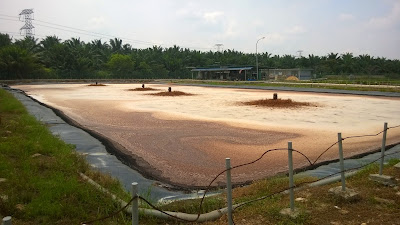After ending the somehow painfully long site visit at Shah Alam Transfer Station, we moved on to Jeram Sanitary Landfill in Kuala Selangor which is quite some distance away from UPM. Operated by Worldwide Holdings as well, Jeram Sanitary Landfill is 1 out of 12 sanitary landfills existed in Malaysia as stated below (information not complete):
- Bukit Tagar Sanitary Landfill operated by KUB-Berjaya Enviro Sdn Bhd in Selangor
- Air Hitam Sanitary Landfill by Worldwide Holdings (closed in 2006) in Selangor
- Jeram Sanitary Landfill by Worldwide Holdings in Selangor
- Tanjung 12 Sanitary Landfill by Worldwide Holdings in Selangor
- Seelong Sanitary Landfill by SWM Sdn Bhd in Johor
- Tanjung Langsat Sanitary Landfill by Pasir Gudang Municipal Council in Johor
- Pulau Burong Sanitary Landfill in Penang
- Kota Kinabalu Sanitary Landfill in Sabah
- Mambong Sanitary Landfill in Kuching, Sarawak
- Bintulu Sanitary Landfill in Sarawak
- Kemuyang Sanitary Landfill in Sibu, Sarawak
- Sibuti Sanitary Landfill in Miri, Sarawak
Sanitary landfill
A landfill is a place where we use to bury rubbish and then cover it with soil so that the land can be reused for other purposes such as building construction or remaking as a park. In terms of aestheticism space-saving, landfill is a better option compared to an open dumping ground which will forever be a rubbish dump. Sanitary landfill is the upgraded version of landfill with strict management to minimise the environmental impact brought by rubbish we produced every day. Simplified steps in setting up a sanitary landfill:
- Get a suitable location (away from residential area & above ground water table)
- Dig a big hole of an inverted pyramid shape
- Line the bottom and sides with a few layers of linings
- Construct some pipes at the bottom to collect leachate
- Start using the landfill, cover daily with lining sheet
Jeram Sanitary Landfill
Jeram Sanitary Landfill was set up at a piece of private land which was previously an oil palm plantation. Even though the soil type is marine clay which is suitable for agricultural purpose and is not suitable for landfill, the operator has no choice because there is no other better place for landfill. in Selangor. Due to high municipal solid waste production rate (solid waste sounds more professional than rubbish, hahaha), this sanitary landfill has to operate all year round. Each day, in average 2 500 tonnes of rubbish (2 500 x 1000 kg) will be dumped here. Try to imagine where does this rubbish have to go if the landfill is having a holiday for just one day.
All the garbage trucks will go to the tipping station of the sanitary landfill upon arrival to be weight as they have to pay for each tonne of rubbish that they send there. Yes, the whole garbage truck will be weight, how cool is that?? Then the content of the trucks will be emptied into the 'cell'. The whole landfill will be divided into cells which are enclosed with layers of linings each to ensure that the waste is secured from escaping into the environment. With every 3 metres thick of rubbish being compacted and spread out, it will be covered. Through calculation, Jeram Sanitary Landfill will reach its maximum capacity and will have to be closed down. A layer of top soil will be placed above the closed landfill and landscaping will be done. Shrubs will be planted to beautify the site for other uses. Even though it is closed down, the generation of methane gas due to anaerobic microorganisms reaction will not stop, thus electricity will continue being generated. Management will still have to be done to ensure no leakage of pollutants from the sanitary landfill.
Leachate treatment system
This is the thing that mesmerised me the most at the sanitary landfill site. Although we have seen the leachate treatment system at the Shah Alam Transfer Station, this one is much much better than the previous one! The leachate will be biologically treated first in three pools respectively by stages, and then being chemically treated with coagulant and flocculant and finally being filtered physically.
 |
| The leachate will be channelled from pool to pool with different types of treatment. This one looks much much better than the previous one. |
 |
| The sludge separated from the leachate. Remember the brown water that we saw in the picture? This sludge is basically odourless and looks like chocolate (think twice before you eat chocolate). |






Thanks for your post on landfills in Malaysia. Wanted to research into that matter but have not gotten around to it yet. This was insightful!
ReplyDeleteHi Sally_barty! Thanks for reading my post and I am glad that you benefit from it! =D
DeleteMore information can be obtained from the website of our National Solid Waste Management Department http://www.kpkt.gov.my/jpspn_en_2013/main.php?Content=articles&ArticleID=83&IID=
Others information I got it from journals =)
Worldwide Holdings also run 2 inert waste landfills in Selangor at Kuang and Dengkil.
ReplyDeleteNice post by the way :) was helpful.
DeleteThanks Sean for your comment =D
DeleteWorldwide Holdings run a couple of sanitary landfills, two inert waste landfills that you mentioned, two dump sites and a transfer station. For more information you can refer to this link.
http://www.whbenvironment.com.my/
Yes, I am well aware. I am in the waste management industry and currently mapping out current active sanitary landfill and open landfills. Have you done any research regarding the matter?
DeleteOh I see. I am currently studying Environmental Science in UPM and had taken the subject solid waste management for one semester. Didn't do much research in detail on this thought.
DeleteThat's fine. Thanks anyways :)
DeleteThanks for reading! It's my pleasure that a professional from this field commented on my article ^^
DeleteAfter 3 years you wrote, i came across your blog.. such inspiring environmentalist. hope you can take care the nature.
ReplyDeleteThank you for your comment, Azimie :)
Delete